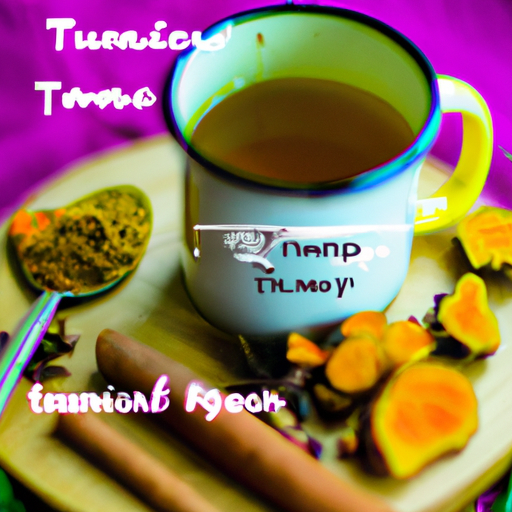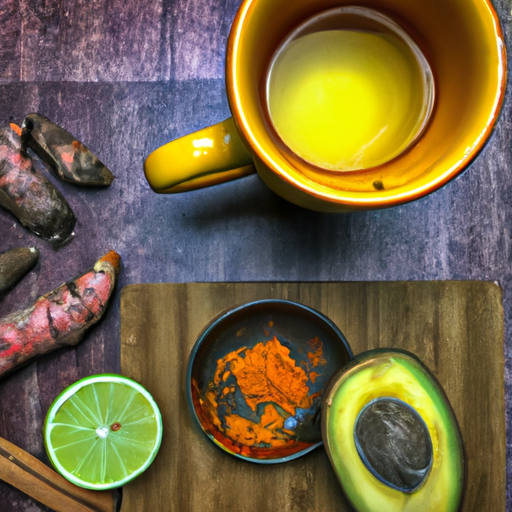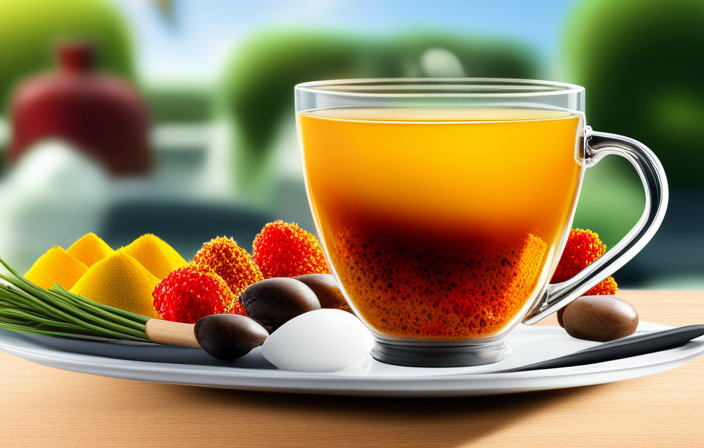Turmeric tea has been praised as a miraculous beverage, with assertions ranging from reducing inflammation to preventing chronic diseases. At the core of these advantages are curcuminoids, the active components present in turmeric root.
But just how much curcuminoids are there in turmeric tea? As a health-conscious individual, I was curious about the amount of this beneficial compound that I am consuming daily through my beloved cup of turmeric tea.
I did some research and discovered that curcuminoids are responsible for many of turmeric’s therapeutic properties. They possess anti-inflammatory, antioxidant, and even anticancer effects. However, not all turmeric products have equal amounts of curcuminoids.
That’s why it’s important to understand how much curcuminoids are present in turmeric tea and its potential health benefits before incorporating it into your diet.
Key Takeaways
- Curcuminoid content in turmeric tea can vary depending on processing methods, storage conditions, and age of the turmeric root.
- Adding black pepper to turmeric tea can increase curcuminoid bioavailability by up to 2000%.
- Consuming large amounts of curcuminoids can have potential risks and side effects.
- Other beneficial compounds can be found in turmeric besides curcuminoids.
What are Curcuminoids?
Curcuminoids are the active compounds found in turmeric that provide its many health benefits. These compounds are responsible for giving turmeric its yellow color and have potent anti-inflammatory and antioxidant properties. Curcumin is the most well-known curcuminoid and has been extensively studied for its potential therapeutic effects.
The health benefits of curcuminoids are numerous, including reducing inflammation, improving brain function, and potentially lowering the risk of chronic diseases such as cancer and heart disease. Turmeric is one of the best dietary sources of curcuminoids, but it can be difficult to consume enough through diet alone.
This is why many people turn to supplements or drinks like turmeric tea to boost their intake of these beneficial compounds.
Turmeric Tea and Curcuminoids
When it comes to turmeric tea and its curcuminoid content, there are a few key factors to consider. First, the amount of curcuminoids present can be affected by factors such as the type of turmeric used and how it was processed.
Additionally, brewing methods can also impact the final curcuminoid content of your tea. As someone who enjoys drinking turmeric tea for its potential health benefits, understanding these factors can help ensure I’m getting the most out of my cup.
Factors Affecting Curcuminoid Content
Did you know that the amount of curcuminoid content in turmeric tea can be impacted by factors such as processing methods, storage conditions, and the age of the turmeric root? Here are three things to consider when looking for high curcuminoid content in your turmeric tea:
-
Processing methods: The way turmeric is processed can affect its curcuminoid content. For instance, boiling or steaming fresh turmeric roots before drying them can help preserve curcuminoids. In contrast, sun-drying or oven-drying may lead to lower levels of these beneficial compounds.
-
Storage conditions: Proper storage also plays a role in maintaining curcuminoids in turmeric. Keeping dried turmeric powder away from light and moisture is recommended to prevent oxidation and degradation of the active components.
-
Age of the root: The older the turmeric root, the lower its curcuminoid content may be. Therefore, it’s best to use fresh or recently harvested roots if possible.
Now that we know about some factors affecting curcuminoid content, let’s explore different types of turmeric used for making tea.
Types of Turmeric Used
If you’re a fan of golden milk, you may be interested in learning about the different types of turmeric that can be used to make this delicious drink.
Turmeric comes in various forms such as fresh, dried and powdered. Fresh turmeric has a slightly different flavor profile compared to its dried or powdered counterpart. It has an earthy and citrusy taste with a hint of bitterness. Meanwhile, dried turmeric often has a more pungent and musky flavor compared to the fresh one.
When it comes to powdered turmeric, there are also variations to take note of. Some brands offer turmeric powder that is made from boiling and drying the root before grinding it into powder form. This type tends to have a less bitter taste but also less aroma than those made through other methods like sun-drying or oven drying.
Knowing these differences in types of turmeric used can significantly affect the taste and potency of your homemade golden milk or turmeric tea.
Moving forward, let’s dive into how brewing methods can further impact the curcuminoid content of your brewed drink.
Brewing Methods
Get ready to elevate your golden milk game with these tips on how to brew the perfect cup and experience the full benefits of this delicious beverage. There are various brewing methods for turmeric tea, each resulting in different flavor profiles and health benefits. The table below summarizes four common methods along with their respective advantages and disadvantages.
| Method | Advantages | Disadvantages | Health Benefits |
|---|---|---|---|
| Boiling water & turmeric powder | Quick and easy | May produce a gritty texture | Good for digestion |
| Simmering fresh turmeric root & spices | More flavorful than using powder | Longer preparation time | Anti-inflammatory, antioxidant properties |
| Steeping turmeric tea bags | Convenient and readily available | Limited flavor profile compared to other methods | Helps boost immunity, anti-inflammatory properties |
| Using a blender to emulsify fats & spices into tea | Creamier texture, enhanced absorption of curcuminoids from fats added | Requires additional equipment and ingredients, more time-consuming | Improved cognitive function, anti-inflammatory effects |
By understanding the differences between these brewing methods, you can tailor your approach based on your preferences or desired health benefits. Now that we know about the different ways to brew turmeric tea let’s dive into how much curcuminoids it contains.
Amount of Curcuminoids in Turmeric Tea
You can increase the amount of curcuminoids in your turmeric tea by adding black pepper, which contains piperine that enhances curcumin absorption.
Curcuminoid absorption and bioavailability in turmeric tea is low due to its poor solubility and rapid metabolism. However, clinical studies show that adding black pepper to turmeric tea can increase the bioavailability of curcuminoids by up to 2000%. The combination of turmeric and black pepper has also demonstrated potential health benefits for inflammation and gut health.
In addition to enhancing curcuminoid absorption, drinking turmeric tea may provide potential health benefits. Curcuminoids have been shown to possess anti-inflammatory properties which may help alleviate symptoms associated with inflammatory conditions such as arthritis and irritable bowel syndrome. Furthermore, research suggests that curcuminoids may support gut health by reducing inflammation and improving gut barrier function.
These findings suggest that incorporating turmeric tea into your diet may offer a natural way to promote overall wellness.
Potential Health Benefits of Curcuminoids
In the previous subtopic, we learned about the amount of curcuminoids present in turmeric tea. Now, let’s dive into the potential health benefits of these powerful compounds. Curcuminoids have been studied extensively for their anti-inflammatory properties and are believed to play a role in reducing chronic inflammation in the body. Chronic inflammation has been linked to numerous health conditions such as heart disease, cancer, and arthritis. By incorporating curcuminoids into our diet through turmeric tea or supplements, we may be able to reduce our risk of developing these conditions.
But that’s not all – studies have also shown that curcuminoids may have positive effects on brain health. Specifically, they may help improve cognitive function and protect against neurodegenerative diseases such as Alzheimer’s. While more research is needed in this area, it’s exciting to think that something as simple as adding turmeric tea to our daily routine could potentially benefit our brain health in the long term.
| Health Benefit | Evidence | Potential Mechanism |
|---|---|---|
| Anti-Inflammatory Properties | Numerous studies show reduction in markers of inflammation | Inhibits pro-inflammatory enzymes and cytokines |
| Brain Health Improvement | Some studies show improved cognitive function and reduced risk of neurodegenerative diseases | May enhance antioxidant activity and reduce accumulation of amyloid plaques |
As we can see from the table above, there is promising evidence for both anti-inflammatory properties and potential brain health improvement with curcuminoids found in turmeric tea. But wait – there are even more health benefits to explore!
Other Health Benefits of Turmeric Tea
Sipping on a warm cup of golden liquid can not only add flavor to your day, but it may also provide additional health benefits such as reducing the risk of heart disease and improving digestion. Turmeric tea recipes have been gaining popularity in recent years due to their potential health benefits.
Some studies suggest that turmeric tea may help with weight loss by boosting metabolism and reducing inflammation. One popular recipe for turmeric tea involves simmering fresh ginger and turmeric in water with honey and lemon juice for added flavor. Other variations include adding cinnamon, black pepper, or coconut milk for a creamier texture.
While there is limited research on the specific effects of drinking turmeric tea, incorporating this anti-inflammatory spice into your diet is generally considered safe and may offer additional health benefits beyond just weight loss. As with any supplement or dietary change, it’s important to consult with a healthcare professional before consuming large amounts of turmeric or starting a new diet plan.
In the next section, we will discuss some precautions and potential side effects associated with consuming too much curcuminoids through supplements or dietary sources like turmeric tea.
Precautions and Side Effects
While turmeric tea has many health benefits, it is important to note that there are potential risks and side effects associated with consuming large amounts of curcuminoids. Some people may experience stomach upset or nausea when consuming high doses of turmeric. Additionally, turmeric can interact with certain medications such as blood thinners and anti-inflammatory drugs.
To avoid these potential risks, it is recommended to consume turmeric in moderation and follow the dosage recommendations on any supplements or products containing curcuminoids. It is also important to consult a healthcare provider before adding large amounts of turmeric or curcumin supplements to your diet, especially if you are taking any medications.
As we move into the next section about how to make turmeric tea, it is important to keep in mind the potential risks and dosage recommendations for using this powerful spice. By following these guidelines, we can enjoy the many health benefits of turmeric without experiencing any negative side effects.
How to Make Turmeric Tea
I love making turmeric tea at home because it’s a tasty and healthy way to start my day. To make this delicious beverage, you’ll need some basic ingredients like fresh turmeric root, ginger, honey, and lemon juice.
Next, follow these step-by-step instructions for brewing your perfect cup of turmeric tea:
- Boil 3-4 cups of water in a pot.
- Add 2 teaspoons of grated or chopped fresh turmeric root and 1 teaspoon of grated or chopped fresh ginger to the boiling water.
- Reduce the heat to low and let it simmer for 10-15 minutes.
- Strain the mixture into a cup and add honey and lemon juice to taste.
Finally, I have some tips to share that’ll help you get the most flavor and health benefits out of your brew.
Ingredients
To get the most out of your turmeric tea, you’ll want to make sure that it contains a sufficient amount of curcuminoids, which are the active compounds responsible for its health benefits.
Here are some of the key ingredients to include in your recipe:
-
Turmeric: This spice is what gives the tea its signature yellow color and provides many health benefits, including anti-inflammatory properties and antioxidant effects.
-
Black pepper: Adding black pepper to your turmeric tea can help increase the bioavailability of curcuminoids by up to 2000%. This is because black pepper contains piperine, a compound that enhances nutrient absorption.
-
Ginger: Another anti-inflammatory ingredient that can complement the effects of turmeric. Ginger also adds a pleasant spicy flavor to the tea.
By using these ingredients together, you can create a flavorful and nutritious drink that packs a powerful punch for your health.
Once you’ve gathered all your ingredients, follow these step-by-step instructions for making delicious turmeric tea at home.
Step-by-Step Instructions
First, gather all your ingredients including black pepper and ginger to enhance the health benefits and flavor of your turmeric tea. Turmeric is known for its anti-inflammatory properties due to the presence of curcuminoids. Curcuminoids are a group of compounds found in turmeric that have been studied extensively for their potential health benefits such as reducing inflammation, protecting against certain chronic diseases, improving brain function, and aiding digestion. Black pepper contains piperine which enhances the absorption of curcuminoids by up to 2000%, while ginger has its own anti-inflammatory properties and adds a nice spicy kick to the tea.
To explore the nuances of brewing turmeric tea for optimal health benefits and flavor profile, refer to the following table:
| Brewing Method | Health Benefits | Flavor Profile |
|---|---|---|
| Boiling water + turmeric powder | Strong anti-inflammatory effects due to high concentration of curcuminoids | Earthy and slightly bitter taste |
| Simmering fresh turmeric root in milk or almond milk | Soothing effect on stomach and may improve sleep quality due to tryptophan in milk; High fat content in milk also aids absorption of curcuminoids | Creamy and rich with a mild spice flavor |
| Cold brew with fresh lemon or orange juice | Vitamin C from citrus fruits enhances absorption of curcuminoids; May aid weight loss due to polyphenols in both turmeric and citrus fruits | Refreshing with a tangy citrus note |
Incorporating these methods into your daily routine can provide numerous health benefits while also adding some variety to your beverage choices. Moving on, let’s discuss tips for brewing the perfect cup of turmeric tea without losing any nutritional value.
Tips for Brewing
Are you ready to brew the perfect cup of golden elixir that’ll have you feeling like a superhero?
To start, make sure your water temperature’s between 195-205°F and steep for at least 10 minutes. This’ll allow the curcuminoids in turmeric to fully infuse into the tea, providing all its health benefits. Adding freshly ground black pepper and grated ginger can also enhance absorption and add extra flavor.
If you want to switch up your turmeric tea routine, try adding different tea additives or flavorings such as honey, lemon juice, or cinnamon. These ingredients not only provide unique flavors but also offer additional health benefits. Just remember to avoid using dairy products as it may interfere with the absorption of curcuminoids.
Looking for other ways to consume turmeric? Let’s explore some creative options!
Other Ways to Consume Turmeric
You can mix turmeric powder into your smoothie or sprinkle it onto roasted vegetables to easily incorporate its health benefits into your meals. Turmeric lattes and turmeric smoothies have also become popular ways to consume the spice. These drinks often contain other ingredients such as ginger, cinnamon, and honey for added flavor and health benefits.
Here is a table that shows the curcuminoid content in different forms of turmeric:
| Form of Turmeric | Curcuminoid Content |
|---|---|
| Fresh Turmeric Root | 1-6% |
| Dried Powdered Turmeric | 2-5% |
| Curcumin Supplements | 95% |
It’s important to note that curcuminoids are not the only beneficial compounds found in turmeric. The spice contains many other bioactive compounds that may contribute to its health benefits, so incorporating it into your diet in various ways can provide a range of benefits.
Frequently Asked Questions
Can curcuminoids be found in other sources besides turmeric?
Yes, curcuminoids can be found in other sources besides turmeric such as ginger and curry powder. These alternative sources also offer health benefits such as anti-inflammatory properties and antioxidant effects.
What is the recommended daily intake of curcuminoids for maximum health benefits?
Oh, just a recommended daily intake of curcuminoids for maximum health benefits? No big deal. Well, studies suggest 500-2,000mg per day may be optimal. But always check with your doctor first!
Is there a difference in the amount of curcuminoids between different brands of turmeric tea?
Brand differences in turmeric tea can affect the curcuminoid content. It is important to check the label for potency and purity. Research suggests a daily intake of 500-2000mg of curcuminoids for maximum health benefits.
Can curcuminoids interact with any medications or supplements?
Interactions with medication are possible when taking curcuminoids. It’s important to consult a healthcare professional before adding it to your regimen. Dosage recommendations vary, but typically range from 500-2000mg/day for therapeutic benefits.
Are there any potential side effects of consuming too much turmeric or curcuminoids?
I should be mindful of turmeric dosage due to potential risks associated with excessive consumption. Curcumin absorption and bioavailability can also impact the effectiveness of any supplements or medications I am taking.
Conclusion
Overall, turmeric tea can be a great source of curcuminoids, which have been shown to have potential health benefits, such as reducing inflammation and improving brain function. It’s important to note that the amount of curcuminoids in turmeric tea can vary depending on various factors, such as the type of turmeric used and how it was processed. However, consuming turmeric tea regularly, alongside a healthy diet and lifestyle, may provide some health benefits.
For example, a study conducted on 40 people with osteoarthritis found that those who consumed a supplement containing curcuminoids experienced significant improvements in pain and physical function, compared to those who received a placebo. This suggests that regular consumption of curcuminoids through sources like turmeric tea may have positive effects on joint health.
Overall, it’s worth incorporating turmeric tea into your routine for its potential health benefits, but it’s always best to consult with your healthcare provider before making any significant changes to your diet or supplement regimen.










